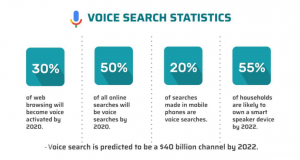Web search is not something new. And for the most part of the World Wide Web age, searches have been dominantly carried out through text.
However, with advancing technology, when every spectrum with how we communicate to technologies, devices and access info, this aspect is also going through a change.
Rise of Voice Search
Voice search has risen tremendously in the past decade, more significantly in the last 3-4 years. In fact, about 20% of search done today is done by voice search. And it isn’t that voice search has gained traction because of the prevalence of mobile phones and it is limited to mobile devices only. Desktop users too are continuously shifting towards voice search mode more and more.
Smart speakers are one such device that has seen voice search grown into a routine for users. With a prediction that by the end of this decade, more than half of searches online (mobile, web, and other devices) will be carried out by voice, web applications are being developed optimized for voice search.
Voice Search is a Dialogue System
First, we will understand what a dialogue system is – It is a setup that creates the platform for conversation between humans and the device pertaining to input and output signals. It is carried out through different modes – text, gestures, speech, and more.
Voice search is an advanced mode of the dialogue system. It works both ways – through an activated virtual assistant, as well as by analyzing the semantics. As soon as you command your device, it assesses the input, identifies the language, captures the keywords, and then results will be displayed accordingly. Text-to-Speech (TTS) is also vertical in this domain. With the advancement in device technology, the result can be displayed as text result or even voice spoke back to the searcher by the device.
Why Voice Search Optimization is Becoming More and More Important?
The growth of voice search is nothing to get surprised with. After all, not just a specific virtual assistant like your Alexa or such device, you want your phone and computer to listen to what you say and provide results.
- It is Fast, Easy and Convenient
Why put in 10-15 seconds to type in something when you can just verbally ask for that in 2-3 seconds. The input is fast and the result you get also comes out fast then. Imagine being cooking and you need your device to display something related to your recipe. Just ask your device for that and it will display the result on the big screen and you are spared of any bother.
- Appropriate for Mobile
Saying something to your smartphone is way more convenient and right rather than typing. You do your typing on your computer and want some ease when working with your smartphone. Increasing use of smartphones for online search is a big reason why voice search has gained so much traction nowadays.
More than 55% of voice search done are done online. And about 60% of mobile users prefer using voice search option.
- Voice Search Results are to the Point
Voice search feature makes use of featured snippets more significantly. And these knowledge graphs and rich snippets are favored by Google more for more apt answers. Therefore, voice search is able to provide you with results more suitable.
Need for Voice Search Optimization
Voice search optimization is something that is gaining huge traction related to what users do online and thus it is impacting SEO. Thereby it is becoming more considerable for a web app development company to improve their site’s voice search optimization strategy.

How to Optimize Your Website for Voice Search?
Based on the evolving changes pertaining to search methodology of the users, web applications and sites are now being expected to be developed with voice search optimization. So, how does a web developer do that? We list down key steps and methods for that:
- Natural and Conversational Language Content
Most of the voice search queries are answered from the rich snippets and features answers on the pages. Thus you need to target ‘question answers’ that include ‘how’, ‘where’, ‘what’, ‘how-to’ and as such. These answers must be written in simple, clear and precise info. A voice search is just like a conversation between two people, and so your website content should be in a conversational tone.
- Make Use of Rich Answers
Rich answers are a preferred source of results for voice searches, as expected with Google. Therefore elements like knowledge graph, knowledge panel, knowledge box, featured snippet and rich answers are aspects that you have to make use of fully.
- Speed Matters
Voice search is done for faster results, and therefore your website speed load should be as fast as possible.
- Filler Words Matter
Searching through text is different from voice search, and filler words like ‘a’, ‘me’, ‘for’ and as such are used when one is verbally asking for a question. Thus your page content and answers must make use of these fillers.
- Longer Content Counts
Pages that appear on Google’s first page are usually long, deep, n about 1800-2000 word length. Therefore longer your content is, probably of landing on the first-page result is higher.
- ‘Near Me’ Searches
A high percentage of voice queries are related to people asking for smoothing nearby, like ‘pizza near me’, ‘gas station near me’, ‘locksmith near me’ and so. Local businesses would do great if they optimize their website for local searches including the ‘near me’ phrase.
- Videos in Result Pages
Natural language query does seem to have likability to videos in answers. Thereby including videos, like ‘how-to’ guides provide a greater impetus for your voice search optimization need.
- Pay Attention to Mobile
Most of the voice searches are done through a mobile device, and so your website has to be mobile responsive. It should be easy to access and load fast on different mobile devices with enhanced content readability.
Conclusion:
Voice search optimization is turning out to be the next challenge for a web app development company or web developers. Implementing the right strategy you should focus on this aspect and you are stand to yield better results for your website’s visibility and reach to the target audience.

